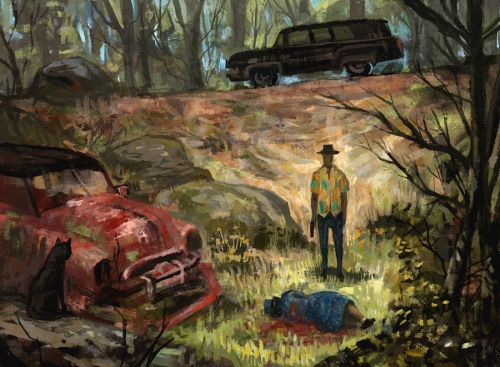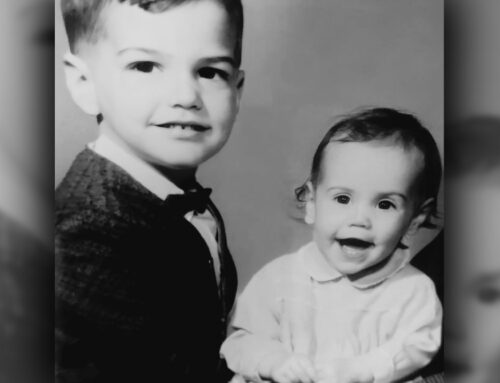Misfits (or, What Makes Flannery O’Connor Such a Good Writer)

The following is a guest blog post I wrote for my friend (and wonderful writer) Eric Wyatt (visit his site)
One of the many brilliant craft elements in Flannery O’Connor’s “A Good Man is Hard to Find” (besides the Most Ironic Title Ever, and the build-up of tension about the Misfit from the very first sentence, something that is sorely lacking in today’s cut-to-the-chase stories and films) is her characterization of the Misfit. Bloggers before me have commented on the names (or lack thereof) in O’Connor’s story, but this one takes the cake. The serial killer’s name is . . . The Misfit? You’re kidding me, right? Not “The Killer,” not “The Phantom Menace,” not “Mr. Big” or “Goldfinger” or “Dr. No” (sorry, I just saw the latest James Bond film), and not even a normal name like Jake or Daryl or Hannibal Lecter? The Misfit. O’Connor seems to be saying, he’s not really evil; he just doesn’t fit in. And immediately (probably subconsciously) we feel sorry for the guy. Think about it: are there any movie characters more pathetic than those found on the Island of Misfit Toys?
Just as O’Connor portrays her villain as at least somewhat sympathetic from the get-go, she refuses to portray the family as likeable. These people are as slipshod and cartoonish as Gary Larson’s “Far Side” characters. (Indeed I would be stunned if Mr. Larson never read Flannery O’Connor.) And none more annoying than the racist grandmother, whose picky, prideful righteousness is what gets them all killed. Yet she is the last to be shot by the Misfit and his merry gang, and it is she who draws out the Misfit’s personal philosophy, she who shakes the Misfit, however momentarily, out of his customary reserve.
In short, O’Connor does the opposite of what bad writers do. (And I should know: I used to be a really bad writer.) Bad writers create good people and bad people, and ramp up the good in the good and exaggerate the bad in the bad. Bad writers characterize people simplistically (the funny way, the dumb blonde, the geek, the whore with a golden heart, etc.) But O’Connor knows that bad people aren’t all bad, and good people (especially the piously good, whom O’Connor lovingly lampoons again and again in her fiction) aren’t all good. So she mocks the family while still depicting their humanity (so that it is still chillingly tragic when they are taken off-stage to be shot), and she takes care to show glimpses of The Misfit’s humanity (he comes from “nice people,” the “finest people in the world”) while still depicting him as the quintessential loner, an iconic serial killer. And even the most superficially pious among them, the Grandmother, who like many people is most earnestly so when faced with imminent death (“She would of been a good woman,” The Misfit said, “if it had been somebody there to shoot her every minute of her life”), is the one character who is able to break through The Misfit’s cool with genuine sympathy—she’s the only one he shoots himself, and the only one who is killed not coolly, out of The Misfit’s sight, but with passion (instinctively reacting to her motherly touch on his shoulder). Even she, in other words, is capable of genuine warmth. (And wasn’t she, after all, the smartest of them all, the one who warned them from the very beginning not to head south because of the killer on the loose?)
So: the good man is hard to find, yes, but the good man is also easy to find (if you think, as Christ did, that everyone’s got a little good in them), and bad men are easy to find, and bad men are hard to find (if you’re like Christ). Nothing is simple; everything (and everyone) is complicated. Whereas every “normal” character thinks, acts, and speaks superficially, The Misfit is the only one who has examined life and found it lacking. (“An unexamined life is not worth living,” said Socrates, and those of us who teach at universities embrace that as our credo. But is it really true? Sometimes examining life makes us miserable—“to think” in this world, said Keats, “is to be full of sorrow”—and you need only look at the personal philosophy of Ted Kaczinski, the infamous Unibomber from the ’80s, for evidence: his examination of the evils of modern technology made a lot of sense, if you could look past the fact that the only reason we know about it is that he killed a lot of innocent people.)
As a result, the story is at once hilarious (We’ve been in an ACCIDENT!”) and chilling (“Lady,” he asked, “would you and that little girl like to step off yonder with Bobby Lee and Hiram and join your husband?” “Yes, thank you,” the mother said faintly.) How many stories can we say that about? (For a great illustration of this, listen to this rare recording of O’Connor reading this story, and you’ll hear the audience’s laughter turn to dead silence.) Bad writers think that a story needs to be either comic or tragic, either “literary” or “light”; good writers know that everything is ambiguous and complicated, that there is light and dark in almost everything, that there is humor in tragedy and meanness in comedy. And all this comes to a head in what is, for me, the best moment of the story: At the end, The Misfit, literally and figuratively touched by the Grandmother, blows a few holes in her chest, leaving the (suddenly very sympathetic) old woman in a puddle of blood. And then O’Connor, in a story full of brilliant small moments (the monkey biting his fleas between his teeth, June Star’s disappointment that none of them was killed in the accident), she gives us this: “Then he put his gun down on the ground and took off his glasses and began to clean them.”
That’s it. That’s our denouement. He cleans his glasses. No evil chortle, no thumping of the chest, no spitting on the ground, no cursing. He cleans his glasses. And we suddenly notice that without his glasses on, The Misfit’s eyes are “red-rimmed and pale and defenseless-looking.” It’s hard, this business of killing people. It wears on one. Something about this old woman has rattled him. He’s human, after all, as are all of O’Connor’s characters. Painfully, hilariously, tragically human.
And then you realize: they’re all misfits. And so are we—we’re all misfits too. As The Misfit says, Jesus “shown everything off balance,” and since nobody on this earth can ever live up to Christ’s stellar example, whether real or mythologized, we all end up feeling inept, inferior, and out of place. And whether it’s The Misfit killing people or us taking pleasure in a well-wrought story featuring him (or for that matter being fascinated by news reports of arbitrary shootings, or laughing at someone else’s misfortune in a high-school hallway, or standing up and cheering during a hockey fight, or roaring with pleasure when a boxer is pummeled in the ring, or feeling secretly glad when our ex-husband or ex-wife is hurt, or gleefully writing a blog post about a story that describes the brutal murders of five innocents), there’s “no pleasure but meanness,” as The Misfit says, and the simultaneous affirmation, questioning, and then denial (at the end, by The Misfit himself) of that idea is what makes this story so enduring, and why it is such a good example of what writing looks like when it’s done well.



